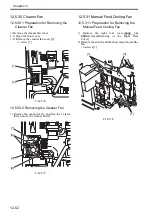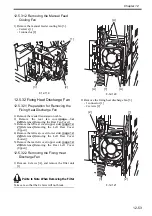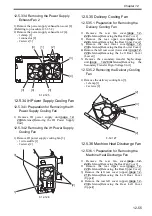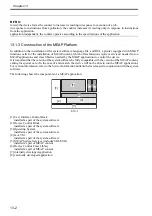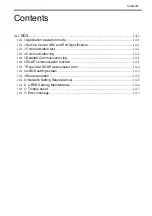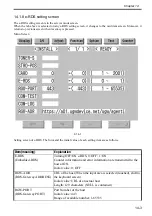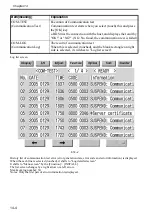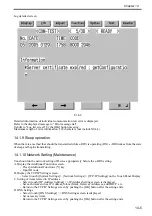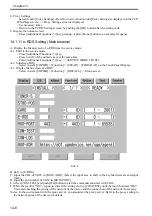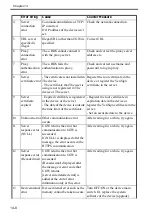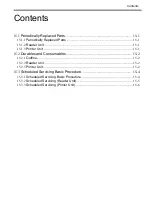
Chapter 13
13-1
13.1 MEAP
13.1.1 Overview
The term MEAP stands for Multifunctional Embedded Application Platform, and is used to generically refer to
a platform for software built into MFPs and peripheral equipment. The architecture is based on Java (J2ME, i.e.,
Java 2 Platform Micro Edition), and is designed to enable the execution of Java applications.
A MEAP application behaves independently from its host printer's system software, and may be installed or
uninstalled using SMS (Service Management Service), which is an interface that runs as part of the browser on
a PC. As long as the device supports MEAP, most MEAP applications may be added to the device in the field.
13.1.2 MEAP Counter
In addition to the commonly found print counters, a device that supports MEAP is equipped with a counter
mechanism used to keep track of which functions are used as well as how often they are used for individual
MEAP applications that are installed. The MEAP counter readings may be checked by making the following
selections on the device control panel: Counter Check Key>MEAP Counter Check. A device may possess the
following MEAP counters, and which counter to use and, therefore, to display all depend on the application in
question.
A counter reading may be of a type that is forced to increase as a job is expected or of a type that is increased
when the application sends instructions; or, it may be of a type that increases independently of the host device,
thus increasing solely in response to the application being run; specifics are as follows:
T-13-1
Type
Count item
forced
total
total (black-and-white 1)
total (black-and-while large)
scan (total 1)
black-and-white scan (total 1)
in response to instructions from application
black-and-white scan 1
black-and-white scan 2
black-and-white scan 3
black-and-white scan 4
application-independent
free 1
free 2
free 3
free 4
free 5
free 6
free 7
free 8
free 9
free 10
free 11
free 12
Summary of Contents for Color imageRUNNER C5180 Series
Page 22: ...Chapter 1 INTRODUCTION...
Page 64: ...Chapter 2 INSTALLATION...
Page 110: ...Chapter 3 BASIC OPERATION...
Page 119: ...Chapter 4 BASIC OPERATIONS AS A PRINTER...
Page 129: ...Chapter 5 MAIN CONTROLLER...
Page 138: ...Chapter 5 5 8 F 5 8 CPU HDD ROM access to the program at time of execution...
Page 165: ...Chapter 6 ORIGINAL EXPOSURE SYSTEM...
Page 209: ...Chapter 7 IMAGE PROCESSING SYSTEM...
Page 212: ...Chapter LASER EXPOSURE 8...
Page 239: ...Chapter 9 IMAGE FORMATION...
Page 324: ...Chapter 10 PICKUP FEEDING SYSTEM...
Page 435: ...Chapter 11 FIXING SYSTEM...
Page 460: ...Chapter 11 11 23 F 11 13 SEN3 SEN2 SEN1 SEN2 SEN3 SEN1 SEN2 SEN3 SEN1...
Page 491: ...Chapter 12 EXTERNALS CONTROLS...
Page 498: ...Chapter 12 12 5 F 12 2 FM1 FM7 FM9 FM2 FM13 FM14 FM12 FM11 FM10 FM5 FM3 FM4 FM8 FM6...
Page 512: ...Chapter 12 12 19 2 Remove the check mark from SNMP Status Enabled F 12 10...
Page 553: ...Chapter 13 MEAP...
Page 557: ...Chapter 14 RDS...
Page 569: ...Chapter 15 MAINTENANCE INSPECTION...
Page 578: ...Chapter 16 STANDARDS ADJUSTMENTS...
Page 597: ...Chapter 17 CORRECTING FAULTY IMAGES...
Page 612: ...Chapter 17 17 14 F 17 7 PLG1 ELCB1 SP1 H4 H3 H2 H1 H1 H2 LA1...
Page 617: ...Chapter 18 SELF DIAGNOSIS...
Page 644: ...Chapter 19 SERVICE MODE...
Page 778: ...Chapter 20 UPGRADING...
Page 823: ...Chapter 21 SERVICE TOOLS...
Page 828: ...APPENDIX...
Page 851: ......





